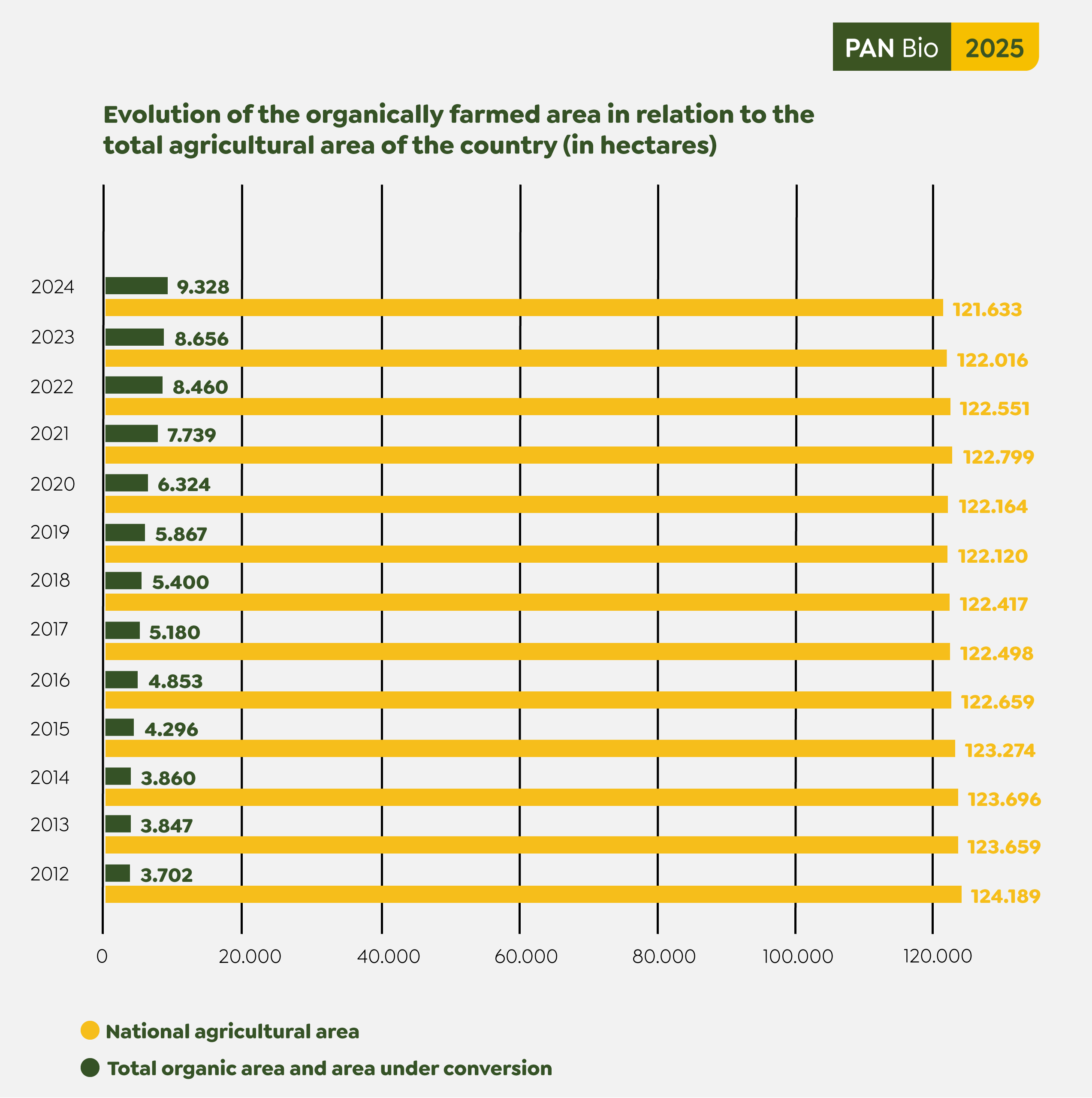Discover organic
Who guarantees that when it says organic on the label, the contents are indeed organic? On the one hand, there is the EU label in the form of a green leaf, which has been valid since 2010 and is in itself a reliable proof of quality. In addition, there are national private organic labels in many European countries that fulfil even stricter criteria than those required by EU legislation. This is why sometimes there is a second organic label on a product in addition to the green leaf. The fact is that all organic products, whether packaged or unpackaged, are closely controlled. For example, a finished loaf of bread on the baker’s shelf can be traced back to the seeds of the grain grown in Luxembourg, or the hazelnuts from Spain back to the producer who grew them there. This is because the labelling obligation is also strictly regulated throughout the EU and ensures transparency and consumer safety, even when importing organic products from third countries. This system has proved to be reliable.
As part of the EU’s farm-to-fork strategy, organic farming and animal husbandry are moreover an important building block for a fair, stable and environmentally friendly food system in Europe – for present and future generations. Certified products are available in organic shops, supermarkets, health food shops, drugstores, discounters and of course at the weekly market. But what exactly is different in the production cycle of food with organic labels?
Organic in brief
The basic idea is quite simple: ecological or organic farming means the production of agricultural products in harmony with nature. Nature is by no means left to its own devices, but is strengthened against disease and pests or weed growth through organic knowledge about favourable plant neighbourhoods, correct sowing times and choice of location and variety. And of course, genetically modified organisms such as manipulated seeds are prohibited.
The organic farmer does without synthetic chemical fertilisers and enriches the soil quality through certain crop rotations – for example, the cultivation of pulses, such as peas, field beans, lupins, vetches, peanuts or clover, increases the nitrogen content of the soil so that subsequent crops such as wheat, which need a lot of nitrogen, are well supplied. As fertilisers, manure and compost from the farm itself are incorporated into the soil as organic material for humus formation.
Ideally, plant cultivation and animal husbandry are closely linked on the organic farm. Out of respect for the natural life cycles, organic farmers strive for as closed a farm cycle as possible, to protect the environment, biodiversity and animal welfare. In the species-appropriate husbandry of the farm animals, the size of the stall, exercise, contact with other animals of the same species and rest periods play a major role.
More information on the structure, profitability and prospects of organic farming in Luxembourg can be found in this brochure: Organic Farming in Luxembourg (in German).
Illustration of a closed nutrient and farm cycle on an organically managed farm (100 % organic).
Organic in numbers
Luxembourg ranks third in the EU in terms of consumption of organic products – but only 20th* in terms of the proportion of organically certified farmland. In Luxembourg, about 5 % of agricultural land is currently designated for organic production. Therefore, many products have to be purchased on the EU internal market and from third countries in order to respond to the population’s ever-increasing demand for high quality, sustainably produced food.
The following table gives an overview of the distribution of the different activities:
| Activity | 2018 | 2019 | 2020 | 2021 | 2022 | 2023 | 2024 |
| Farmers | 77 | 82 | 83 | 98 | 101 | 95 | 117 |
| Market gardeners | 12 | 14 | 16 | 19 | 19 | 20 | 19 |
| Winemakers | 15 | 15 | 17 | 21 | 22 | 23 | 23 |
| Fruit farmers | 11 | 11 | 11 | 16 | 22 | 24 | 28 |
| Beekeepers | 15 | 19 | 22 | 21 | 21 | 24 | 28 |
| Breeding farms and other small activities | 4 | 5 | 9 | 13 | 17 | 22 | 26 |
| Speciality crops | – | – | – | – | – | 2 | 2 |

Advantages of an organic farm
Organic farmers manage their farms predominantly with locally available resources; they feed home-grown fodder and focus, for example, on indigenous fruit varieties or cereals adapted to the local climate. Management is focused on the preservation or improvement of water and soil quality.
- Organic farming promotes the binding of atmospheric nitrogen through the cultivation of legumes and ensures sustainable soil fertility. This positive influence on the biological activity of the soil sustainably reduces the risk of erosion and increases the capacity to store and absorb water.
- By avoiding the use of synthetic chemical pesticides and easily soluble fertilisers, organic farming enriches the diversity of flora and fauna – the key word being bees!
- Organic farming constitutes active and direct climate protection, because without the use of synthetic chemical pesticides and fertilisers, which have to be produced with high energy consumption, carbon dioxide and ammonia emissions are greatly reduced. Organic farming also favours the use of organic fertilisers made from bio-effective substances.
- Drinking water quality increases because of reduced nitrate leaching and pesticide residues.
- Agricultural land and agricultural production are largely in balance.
* Regulation (EC) No 2018/848, which regulates ecological/organic production and labelling of organic products, can be read here in 24 languages.
UN Sustainable Development Goals
Virtually all of the sustainability goals formulated by the UN directly interface with or are indirectly intertwined with food production. Organic agriculture is an excellent tool for combining food production and sustainability.
![]()
